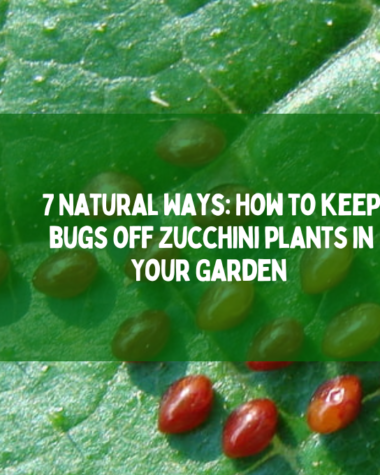Choosing the best soil, variety, and location for planting, as well as providing consistent moisture and proper nutrients, regular pruning and pest control measures, such as natural predators or safe insecticides, rotating crops, and using mulch, are the factors that are important for zucchini plant care.
Zucchini plants are a popular summer squash variety that is easy to grow. With proper care and attention, zucchini plants can produce an abundance of nutritious and delicious fruits throughout the growing season.
In this article, I will discuss tips on zucchini plant care for a bountiful harvest.
Let’s start.
8 Tips for Zucchini Plant Care

Zucchini plants are a popular choice for home gardens due to their prolific production of tasty and nutritious fruits.
The following 8 tips for zucchini plant care are given below:
1. Plant Seeds In Best Soil
To ensure the best possible growth and yield, it is important to plant the seeds in the best possible soil. Zucchini plants prefer soil that is well-drained, nutrient-rich, and has a pH level between 6 and 7.
When planting the seeds, make sure that they are planted at a depth of 1-2 inches and spaced at least 24 inches apart. With proper soil preparation and care, your zucchini plants should thrive and produce a bountiful harvest.
Related Reading
- 7 Reasons Why is my Zucchini Plant Not Producing Fruit?
- 8 Zucchini Planting Tips For Best Harvest
- Companion Planting Guide: Best Plants to Grow with Zucchini for Healthy and Bountiful Harvest
- How to Find, Prevent, and Treat Zucchini Plant Problems?
2. Try To Choose Best Variety

When selecting a zucchini variety, it is also important to consider your climate and growing conditions. Some varieties may perform better in cooler or warmer climates, while others may be more tolerant of drought or heat.
There are several factors to consider when selecting a variety, such as the plant’s size, color, and flavor of its fruit, as well as its resistance to pests and diseases.
Popular zucchini varieties include Black Beauty, which produces dark green fruit with a slightly nutty flavor, and Yellow Crookneck, which produces yellow, curved fruits.
If you are looking for a smaller plant, consider growing the Bush Baby variety, which is perfect for container gardening.
3. Sunlight And Watering System
Watering and sunlight are critical factors in the care of zucchini plants. These plants require full sun, which means they need at least six hours of direct sunlight each day to grow and produce fruit.
When it comes to watering, zucchini plants require consistent moisture, but not too much. Overwatering can lead to root rot and other problems. So, water the plants deeply once a week or more frequently during hot, dry weather.
It is also important to water the plants at the base to avoid wetting the leaves and promoting disease. You can use a drip irrigation system for plants to receive consistent moisture without wasting water.
4. Fertilize Regularly
It is important to fertilize the plants regularly throughout the growing season. These plants require nutrient-rich soil to grow and produce healthy fruit.
Before planting, it’s important to work compost or other organic matter into the soil to increase its fertility. A balanced fertilizer with equal amounts of nitrogen, phosphorus, and potassium can help promote healthy growth and fruit production.
It is better not to over-fertilize, as it can lead to excessive foliage growth and a reduction in fruit production.
5. Mulching For Conserve Moisture
Mulching is an effective way to conserve moisture in the soil and promote healthy zucchini plant growth. A layer of organic mulch, such as straw, leaves, or grass clippings, can help retain moisture in the soil, reduce weed growth, and regulate soil temperature.
Mulch also provides a barrier between the soil and the zucchini fruits, helping to prevent soil-borne diseases. Apply a 2- to 3-iinch layer of mulch around the base of the zucchini plants.
By mulching regularly, you can help your zucchini plants thrive and produce a bountiful harvest.
6. Pruning For Better Growth
By removing dead or damaged leaves and branches, you can improve air circulation around the plant and reduce the risk of disease.
Pruning can also help control the size of the plant and promote the growth of new, healthy branches. Pinching off the tips of the main stems when the plant is about 3 feet tall can help stimulate branching and increase fruit production.
It’s important not to prune too much, as this can reduce the plant’s ability to produce fruit.
7. Pest Control System

Implementing an effective pest control system is crucial for zucchini plants. Common pests that can affect zucchini plants include squash bugs, cucumber beetles, and aphids.
One method of pest control is to use natural predators, such as ladybugs and lacewings, which feed on these pests. You can also try using insecticidal soap or neem oil, which are effective and safe methods for controlling pests.
It is also important to regularly inspect your plants for signs of pests or damage and to remove any affected leaves or fruits.
8. Rotation of Crops
Rotating crops can help prevent soil-borne diseases and promote healthy growth. Zucchini plants are heavy feeders, so it is important to rotate them with other crops to give the soil time to recover.
Rotate zucchini plants every two to three years to avoid planting them in the same spot each year. Rotating legumes, such as beans or peas, can help add nitrogen to the soil and improve its fertility.
Related Reading
- 10 Reasons Your Tomato Plant Leaves Are Turning Brown
- Diseases of Pumpkin Plants: Identification, Treatment, and Prevention Strategies
- What Is The Best Cucumber Plant Spacing For High Yields?
- The Incredible Benefits of Providing Aubergine Plant Support
Conclusion
Taking care of zucchini plants requires attention to several critical factors, including soil quality, watering, sunlight, fertilization, mulching, pruning, pest control, and crop rotation. All the factors play a role on their own.
By taking care of zucchini plants, you can grow them healthy and produce a bountiful harvest.
Thanks for reading!







